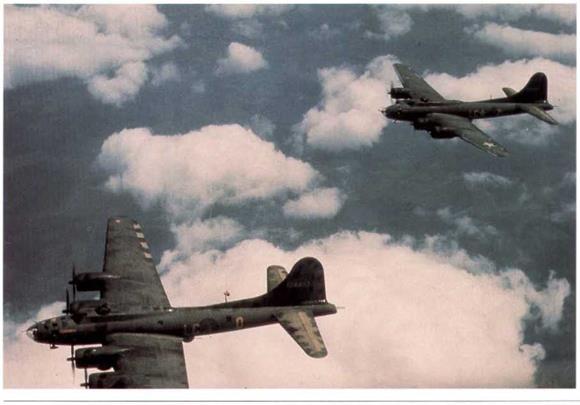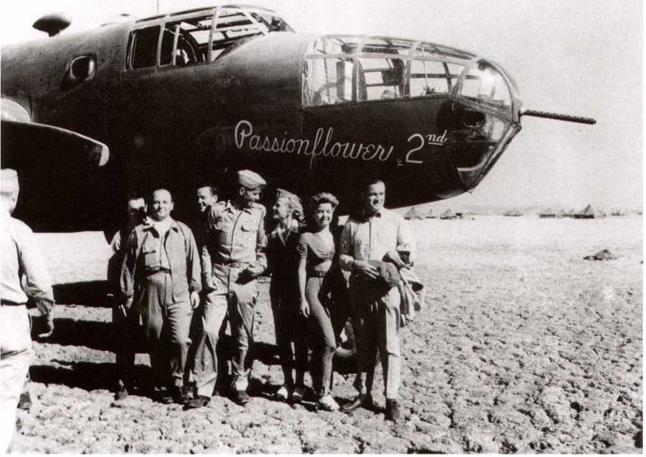T. О. 07-ЫВ, issued on June 29,1943, orders immediate use of the new insignia
The same day that the revised version of AN-19a introduced the new rectangular bar insignia, HQ. AAF issued a revision to T. O. 07-11, which stated that:
The work directed herein will be accomplished immediately by service activities with the aid of sub-depots, if necessary. Under para. 4. STANDARD INSIGNIA., it stated:
a. A cocarde of new design as described below will be placed on all aircraft of the AAF immediately. (Refer to figure 11.)
(1) A five pointed white star within a blue circle (as formerly),
(2) The straight line formed by the top edges of the two star points which are located to the left and right respectively of the upper star point, will be extended outward a distance equal to 1 radius of the circle on either side. Draw lines perpendicular to this line at each end and extending downward for a distance equal to 1/2 the radius of the circle. Draw lines parallel to the above horizontal line from the ends of the two perpendicular lines until they intersect the circle. The bars thus created will be painted white.
(3) Using a width which is 1/8 the radius of the circle, describe a border of red around the entire design outlined in paragraphs 4.a.(l) and (2).
At the end of this section of the T. O., the following was added:
NOTE: Existing insignia may be reworked by adding the white rectangular areas and the red border provided that the provisions of paragraphs 4.b. and c. are complied with in so doing.
Results of camouflage speed test sent to Commanding General, Eighth Air Force, England, by HQ. VII! Bomber Command, dated July 1, 1943.
In accordance with the earlier request to delete camouflage from its aircraft, the 1st Bomb Wing ran camouflage speed tests on a B-17F, with its original camouflage applied and then with it removed, to check the improvement, if any, in its speed. The report stated that removal of the camouflage required the removal of all fabric covered surfaces and the engine cowlings before the job could be started. It took 1,300 man-hours to complete the operation, using 155 gallons of paint remover, one bale of rags, and eight pounds of steel wool. It took this much effort because it was the first time it had been done in the field, there was a lack of paint brushes, lack of a sufficiently strong paint remover, and lack of proper stands to facilitate access all over the aircraft. It was considered that fifty gallons of double strength paint remover would be sufficient to do the job if brushes were available instead of rags. B-17F, serial number 42-29780, was used for the tests.
North American B-25H-NA. of the 823rd BF, 38th BG, оГ the 5th Air Force in the Pacific area, shows both its fearsome tiger marking and its 75mm cannon and four 0.5 inch guns in the nose. It is in the normal dark olive drab and neutral gray camouflage. (March AFB Museum)

 |
North American B-25J-1, possibly 433892, of the 823rd BS, 38th BG. F ifth Air Force in July 1943. (March AFB Museum)
|
The results showed that the speed gain varied between 2.3 and 3.2 miles per hour, and it could be expected that a maximum gain of 4-5 miles per hour would result from removing the camouflage paint. In view of the small gain in speed, it was not recommended to remove camouflage paint from operational aircraft. HQ. VIII Bomber command agreed with this recommendation in their letter to the CG., Eighth Air Force. (This small speed increase was in contrast to the earlier assertion that 20 to 25 miles per hour could be gained – author).
T. 0.07-1-1C fixes diameter of the new wing insignia, July 3,1943
A few days after the new insignia was issued, a change was made to the wing insignia size. The new order read : “Diameter of the blue circle will be 75 percent of the distance between the leading edge of the wing and the aileron cut-out except that the circle will not be greater than 60 nor less than 30 inches in diameter.”
Smooth surface camouflage report released, July 9,1943.
Smooth surface camouflage was discussed in a report issued on July 9,1943 by Eng. Div. (WF). The smooth finish, which had been tested at both Eglin Field and WF, was discussed thoroughly. Eglin Field had also issued a final report, No. 3-43-48, dated May 12, 1943, of additional comparative tests, and this was attached to the WF report. The reports concluded that:
A definite gain of from 1% to 2 % in top speed.
There would be no decrease in camouflaging qualities or delay in production if the smoothing operation was properly fitted into the production schedule.
 Boeing B-17F-10-BO, 4124453, aircraft LG-O, and LG-P, of the 322nd BS, 91st BG, in the pre-June 1943 insignia. Note that the hlue-over-yellow outlined fuselage insignias have been heavily grayed over, unlike those on the wing upper surfaces. Note the heavily-applied medium green blotches all over the aircraft. They show up particularly well on the fabric doped surfaces. (USAF)
Boeing B-17F-10-BO, 4124453, aircraft LG-O, and LG-P, of the 322nd BS, 91st BG, in the pre-June 1943 insignia. Note that the hlue-over-yellow outlined fuselage insignias have been heavily grayed over, unlike those on the wing upper surfaces. Note the heavily-applied medium green blotches all over the aircraft. They show up particularly well on the fabric doped surfaces. (USAF)
|
Bell P-39L-1-BE, 42-4520, is shown in the summer of 1943 in North Africa, as aircraft “V” of the 350th FG, Twelth Air Force. It had previously served with the 81st FG, as “X-R”. It is shown with the new red outline insignia of June 1943. (Robert L. Baseler) |
In view of these facts, Eng. Div. recommended that all camouflaged combat aircraft be smoothed and the current painting procedures and specs, be modified to require a minimum of smoothing effort. They also recommended that aircraft manufacturers be requested to review their aircraft designs and methods of construction to prevent dents, skin lap joints and poorly fitting doors, as the resulting drag could be greater than that of rough camouflage paint.
Eglin Field run tests on camouflage of bombardment aircraft, July 12,1943.
On July 12, 1943, Eglin Field made an interim report on tests they were running to determine whether or not bombardment aircraft should be camouflaged differently than the basic camouflage for fighter aircraft. The otive drab color had been developed primarily to protect fighters from observation from above. This color was also used on the sides as well as on the top of the aircraft, because the side areas were small and unimportant.
However, on bombardment aircraft, the increased side area made a specific color coloration necessary for those areas, since the dark olive drab on the side areas silhouetted the aircraft against a bright sky when seen from the side.
Eglin Field believed that camouflaging the under surfaces of bombardment aircraft was unimportant, thus the camouflage could be omitted, also saving weight. They recommended that a gray color be used for camouflaging the sides of bombardment aircraft. Their final report, No. 3-43-77, “Test of Daytime Camouflage for Heavy Bombardment Type Aircraft”, was issued on November 12, 1943.
On August 5,1943, Eng. Div. (WF) informed the Mat. Div., (Wash.), that they felt that painting the sides of aircraft was effective in reducing recognition of low flying aircraft, but that olive drab was better camouflage when viewed from an angle above the aircraft. They also believed that the same coloration would not be effective in all situations, and therefore different colors should be used depending, on the background (sky, water, or land) against which the aircraft would be seen, to achieve the best camouflage effect.
Eglin Field reports on test to increase the visibility of training aircraft, July 28, 1943
Report No. 3-43-99, “Test to Increase Visibility of Training Planes”, was issued by Eglin Field on July 28, 1943. Unfortunately, this is another of the missing reports referred to earlier, but we do know that on December 26,1943, a major revision of T. O. 07-1-1 included new requirements for special trainer markings. No other changes were made to trainer markings prior to this time, so it is most likely that these resulted from the Eglin Field test. The changes affected only aircraft used for instrument training and consisted of adding large areas of insignia red to various parts of the trainer aircraft (see paragraph 3f of the revised T. O. 07-1-1 later in this chapter).
Tech. Sub-Committee on Camouflage asked to approve colors for high-altitude aircraft camouflage, August 13,1943.
A memo dated August 13, 1943, was sent to members of the Tech. Sub-Committee on Camouflage telling them that the suggestion that Army, Navy, and British ideas be exchanged, might prove useful in the development of high altitude camouflage. The members were asked to signify their approval of colors to be added to the AN Standard aircraft camouflage colors. (Note: the British already had a wide range of such colors, such as PRU Blue, Sky Blue, Deep Sky, and Dark Mediterranean Blue, developed for use on their high flying fighters and reconnaissance aircraft. In view of the earlier cooperation between the two countries on standardizing camouflage colors, it is surprising that at this date that such a request should have to be made. Possibly, it was a result of the feelings re British type camouflage expressed earlier by the Dir. Mil. Req, – see the entry for July 27,1942, In the event, Lockheed ended up by painting all of the later F-5A aircraft in a color very similar to the RAF PRU Blue – author).
|
|
Bob Hope’s entertainment group is shown arriving at Mateur, Tunisia, on August 10, 1943. They were flown in the 325th FGs B – 25 “Passion Flower 2nd”. Lt. Col. Baseler is in the center of the group, with Frances Langford and Bob Hope at the right. (Robert L. Baseler)
|
|
North American B-25D-15-NC, 41-30428, is seen with the Twelfth Air Force in North Africa in 1943. The aircraft is camouflaged in the special North West African scheme of March 1943. (March AFB Museum)














